Finance Assignment: Shareholder Wealth, Risk, and Returns Analysis
VerifiedAdded on 2020/02/24
|15
|1193
|123
Homework Assignment
AI Summary
This finance assignment solution addresses key concepts in financial management, including shareholder wealth maximization, risk and return analysis, and investment strategies. The solution begins with calculations related to future value of annuity and present value of cash flows. It then explores the differences between profit maximization and shareholder wealth maximization, emphasizing the long-term perspective and the importance of considering risk. The solution also includes an analysis of market data for Commonwealth Bank (CBA) and Rio Tinto (RIO), utilizing the CAPM model and Security Market Line (SML) to evaluate their performance and make investment recommendations. The analysis involves calculating holding period returns, standard deviations, and expected returns, providing a comprehensive assessment of the investment opportunities. The document concludes with a comparison of CBA and Rio Tinto, suggesting an investment in Rio Tinto based on the analysis.
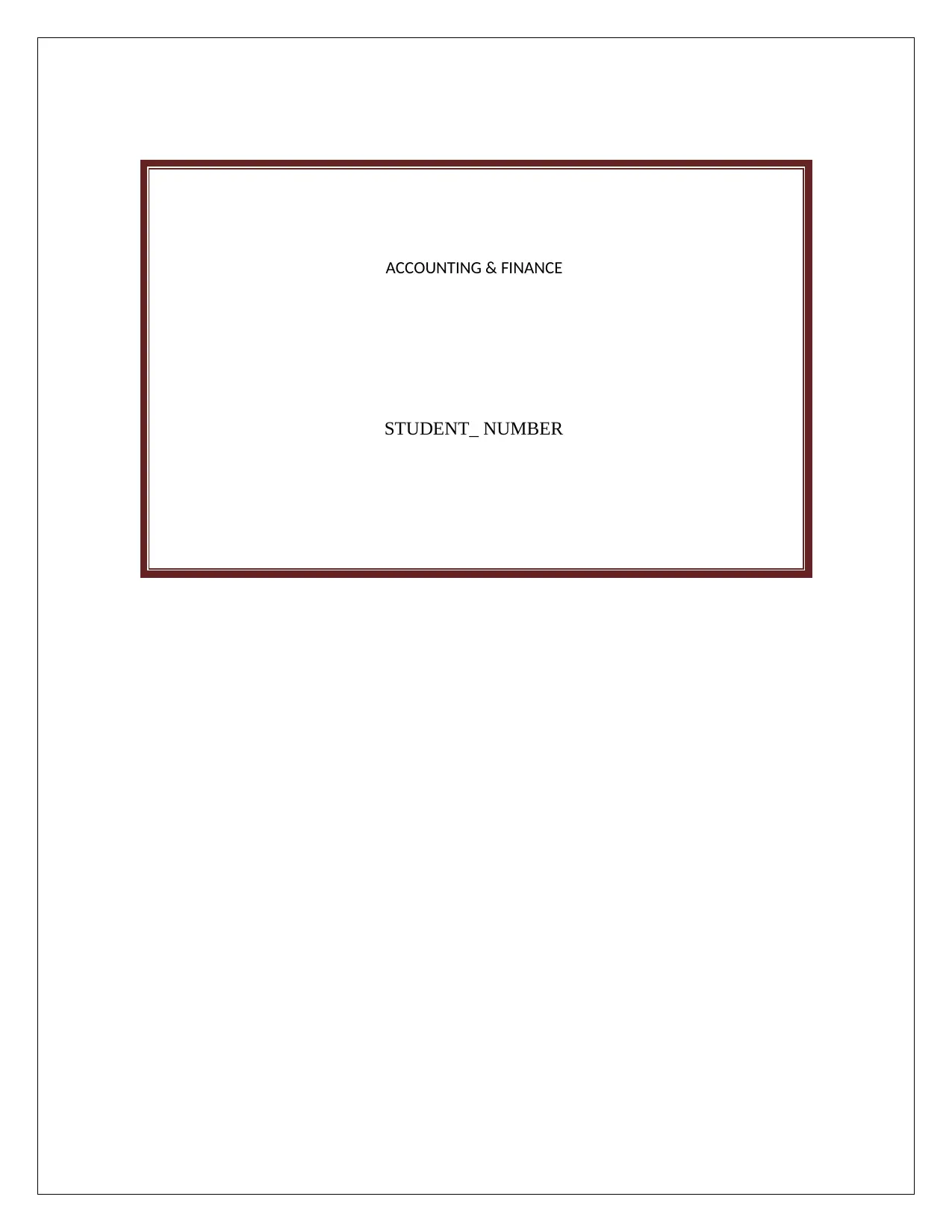
ACCOUNTING & FINANCE
STUDENT_ NUMBER
STUDENT_ NUMBER
Paraphrase This Document
Need a fresh take? Get an instant paraphrase of this document with our AI Paraphraser
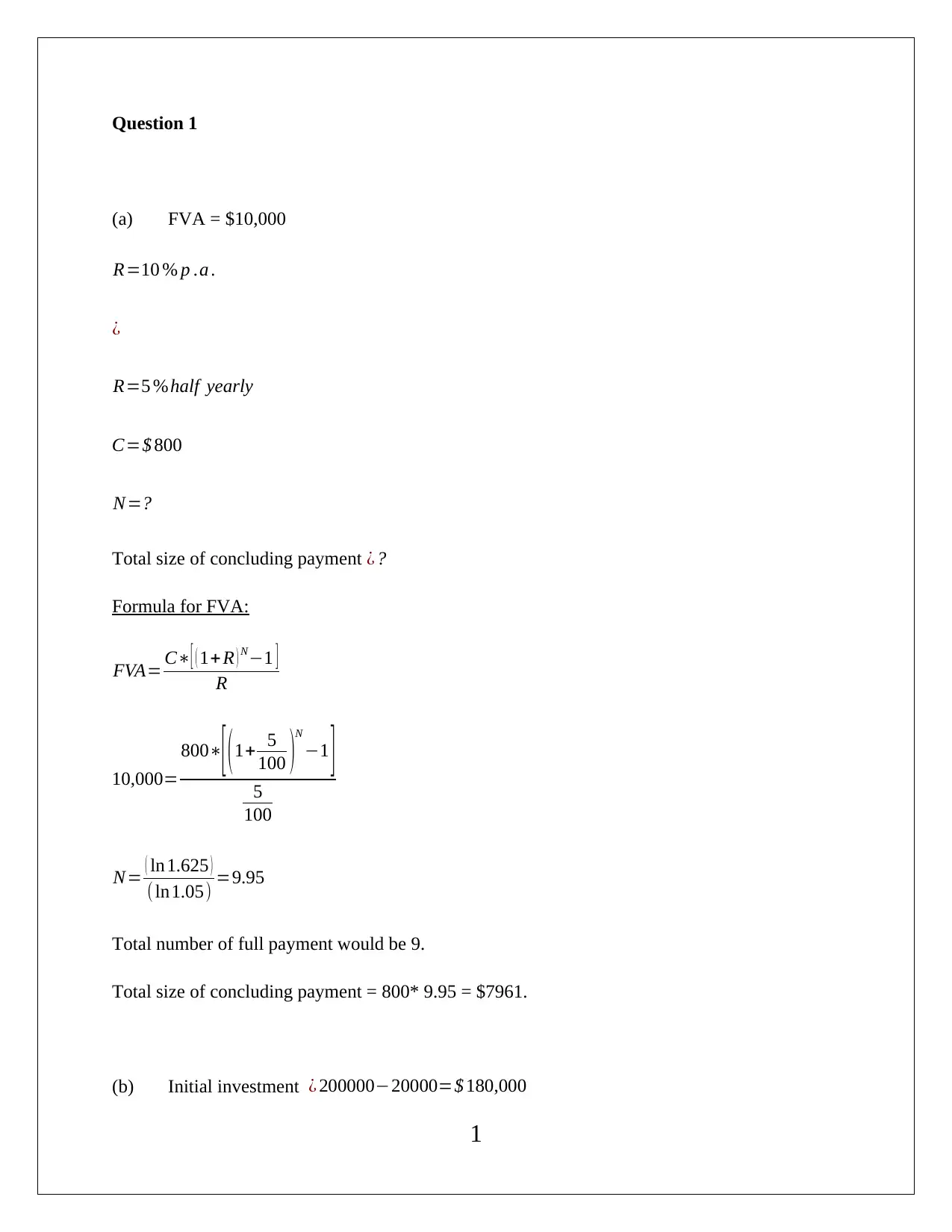
Question 1
(a) FVA = $10,000
R=10 % p .a .
¿
R=5 %half yearly
C=$ 800
N=?
Total size of concluding payment ¿ ?
Formula for FVA:
FVA= C∗[ ( 1+R ) N−1 ]
R
10,000=
800∗[ ( 1+ 5
100 )
N
−1 ]
5
100
N= ( ln 1.625 )
( ln1.05) =9.95
Total number of full payment would be 9.
Total size of concluding payment = 800* 9.95 = $7961.
(b) Initial investment ¿ 200000−20000=$ 180,000
1
(a) FVA = $10,000
R=10 % p .a .
¿
R=5 %half yearly
C=$ 800
N=?
Total size of concluding payment ¿ ?
Formula for FVA:
FVA= C∗[ ( 1+R ) N−1 ]
R
10,000=
800∗[ ( 1+ 5
100 )
N
−1 ]
5
100
N= ( ln 1.625 )
( ln1.05) =9.95
Total number of full payment would be 9.
Total size of concluding payment = 800* 9.95 = $7961.
(b) Initial investment ¿ 200000−20000=$ 180,000
1
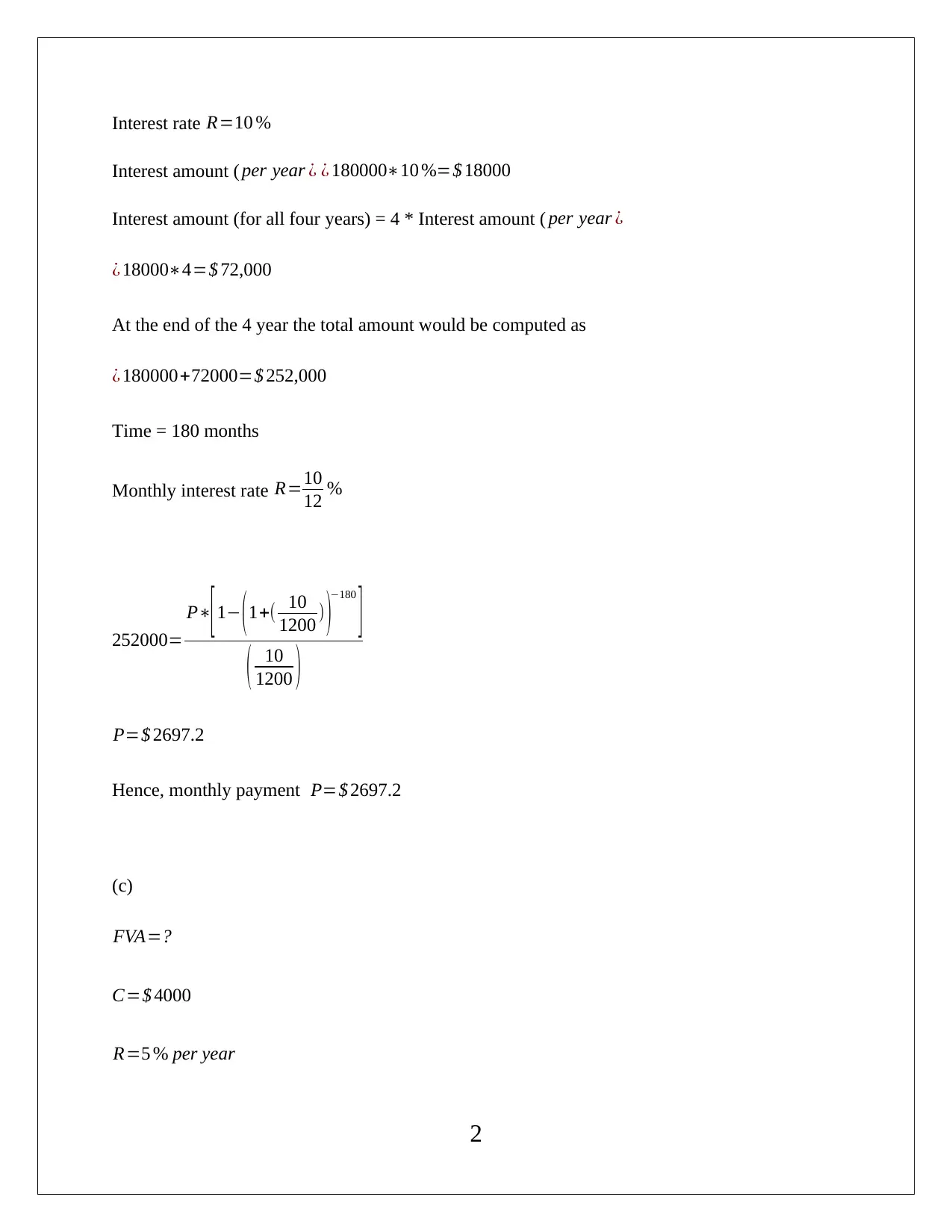
Interest rate R=10 %
Interest amount ( per year ¿ ¿ 180000∗10 %=$ 18000
Interest amount (for all four years) = 4 * Interest amount ( per year ¿
¿ 18000∗4=$ 72,000
At the end of the 4 year the total amount would be computed as
¿ 180000+72000=$ 252,000
Time = 180 months
Monthly interest rate R=10
12 %
252000=
P∗
[1− (1+( 10
1200 ) )−180
]
( 10
1200 )
P=$ 2697.2
Hence, monthly payment P=$ 2697.2
(c)
FVA=?
C=$ 4000
R=5 % per year
2
Interest amount ( per year ¿ ¿ 180000∗10 %=$ 18000
Interest amount (for all four years) = 4 * Interest amount ( per year ¿
¿ 18000∗4=$ 72,000
At the end of the 4 year the total amount would be computed as
¿ 180000+72000=$ 252,000
Time = 180 months
Monthly interest rate R=10
12 %
252000=
P∗
[1− (1+( 10
1200 ) )−180
]
( 10
1200 )
P=$ 2697.2
Hence, monthly payment P=$ 2697.2
(c)
FVA=?
C=$ 4000
R=5 % per year
2
⊘ This is a preview!⊘
Do you want full access?
Subscribe today to unlock all pages.

Trusted by 1+ million students worldwide
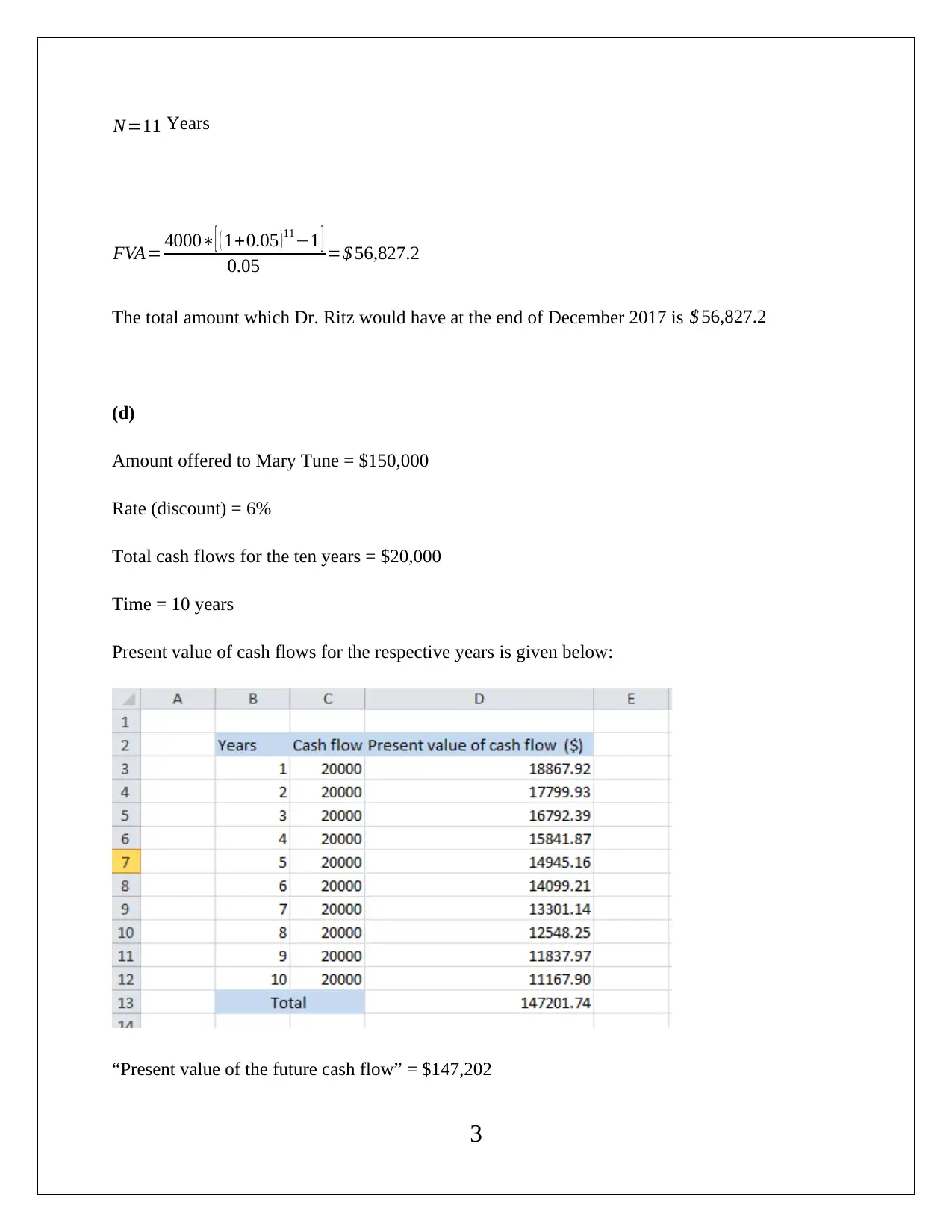
N=11 Years
FVA= 4000∗[ ( 1+0.05 )11−1 ]
0.05 =$ 56,827.2
The total amount which Dr. Ritz would have at the end of December 2017 is $ 56,827.2
(d)
Amount offered to Mary Tune = $150,000
Rate (discount) = 6%
Total cash flows for the ten years = $20,000
Time = 10 years
Present value of cash flows for the respective years is given below:
“Present value of the future cash flow” = $147,202
3
FVA= 4000∗[ ( 1+0.05 )11−1 ]
0.05 =$ 56,827.2
The total amount which Dr. Ritz would have at the end of December 2017 is $ 56,827.2
(d)
Amount offered to Mary Tune = $150,000
Rate (discount) = 6%
Total cash flows for the ten years = $20,000
Time = 10 years
Present value of cash flows for the respective years is given below:
“Present value of the future cash flow” = $147,202
3
Paraphrase This Document
Need a fresh take? Get an instant paraphrase of this document with our AI Paraphraser
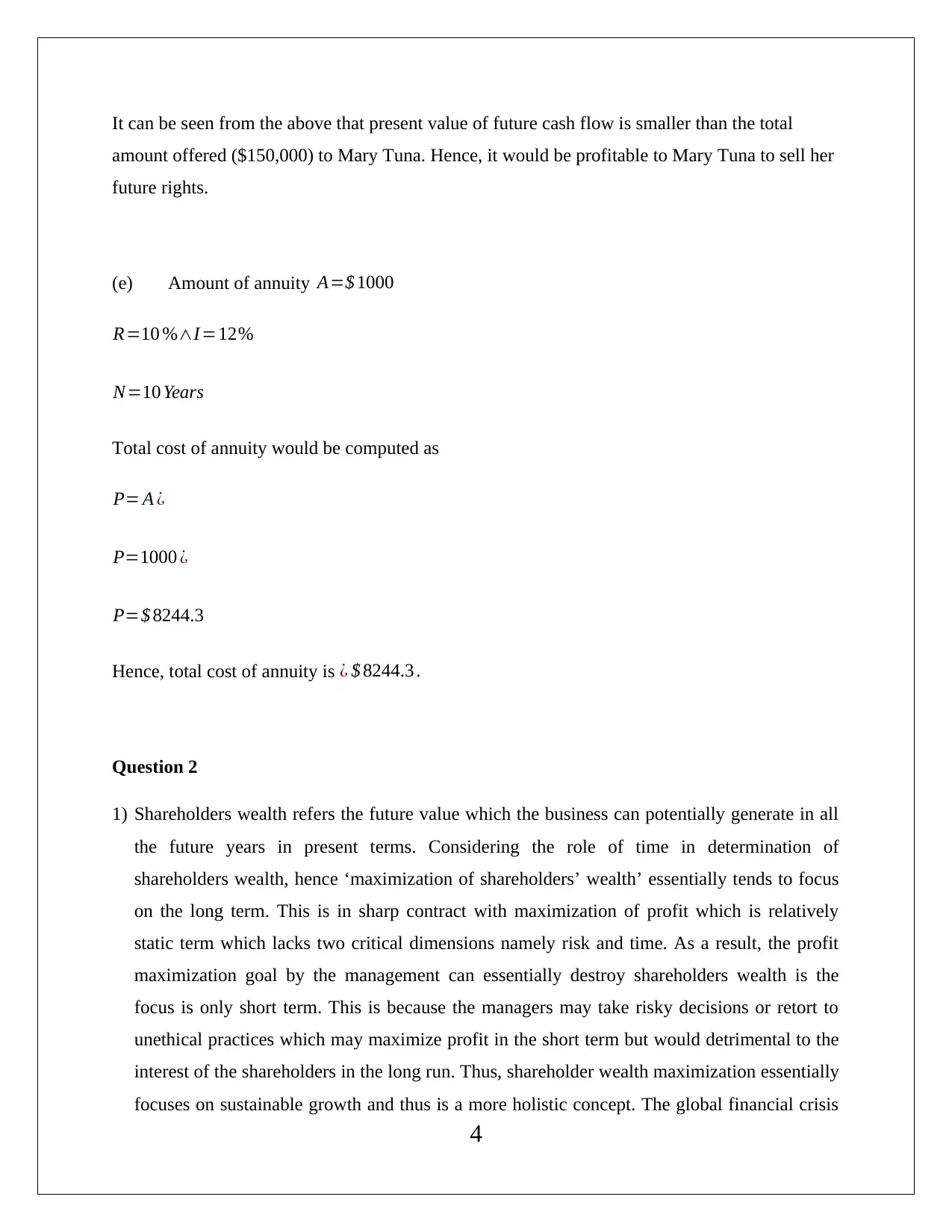
It can be seen from the above that present value of future cash flow is smaller than the total
amount offered ($150,000) to Mary Tuna. Hence, it would be profitable to Mary Tuna to sell her
future rights.
(e) Amount of annuity A=$ 1000
R=10 %∧I=12%
N=10 Years
Total cost of annuity would be computed as
P= A ¿
P=1000 ¿
P=$ 8244.3
Hence, total cost of annuity is ¿ $ 8244.3 .
Question 2
1) Shareholders wealth refers the future value which the business can potentially generate in all
the future years in present terms. Considering the role of time in determination of
shareholders wealth, hence ‘maximization of shareholders’ wealth’ essentially tends to focus
on the long term. This is in sharp contract with maximization of profit which is relatively
static term which lacks two critical dimensions namely risk and time. As a result, the profit
maximization goal by the management can essentially destroy shareholders wealth is the
focus is only short term. This is because the managers may take risky decisions or retort to
unethical practices which may maximize profit in the short term but would detrimental to the
interest of the shareholders in the long run. Thus, shareholder wealth maximization essentially
focuses on sustainable growth and thus is a more holistic concept. The global financial crisis
4
amount offered ($150,000) to Mary Tuna. Hence, it would be profitable to Mary Tuna to sell her
future rights.
(e) Amount of annuity A=$ 1000
R=10 %∧I=12%
N=10 Years
Total cost of annuity would be computed as
P= A ¿
P=1000 ¿
P=$ 8244.3
Hence, total cost of annuity is ¿ $ 8244.3 .
Question 2
1) Shareholders wealth refers the future value which the business can potentially generate in all
the future years in present terms. Considering the role of time in determination of
shareholders wealth, hence ‘maximization of shareholders’ wealth’ essentially tends to focus
on the long term. This is in sharp contract with maximization of profit which is relatively
static term which lacks two critical dimensions namely risk and time. As a result, the profit
maximization goal by the management can essentially destroy shareholders wealth is the
focus is only short term. This is because the managers may take risky decisions or retort to
unethical practices which may maximize profit in the short term but would detrimental to the
interest of the shareholders in the long run. Thus, shareholder wealth maximization essentially
focuses on sustainable growth and thus is a more holistic concept. The global financial crisis
4
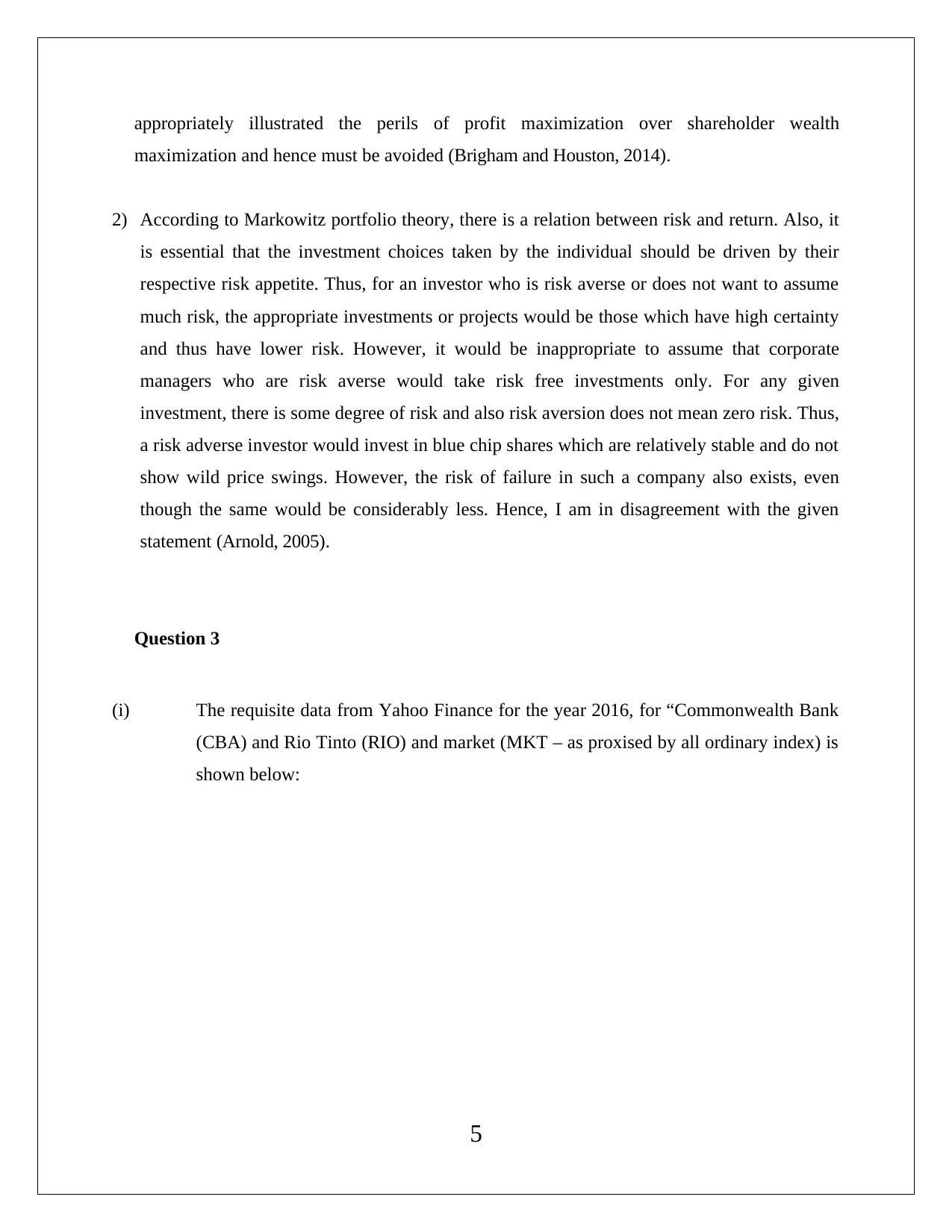
appropriately illustrated the perils of profit maximization over shareholder wealth
maximization and hence must be avoided (Brigham and Houston, 2014).
2) According to Markowitz portfolio theory, there is a relation between risk and return. Also, it
is essential that the investment choices taken by the individual should be driven by their
respective risk appetite. Thus, for an investor who is risk averse or does not want to assume
much risk, the appropriate investments or projects would be those which have high certainty
and thus have lower risk. However, it would be inappropriate to assume that corporate
managers who are risk averse would take risk free investments only. For any given
investment, there is some degree of risk and also risk aversion does not mean zero risk. Thus,
a risk adverse investor would invest in blue chip shares which are relatively stable and do not
show wild price swings. However, the risk of failure in such a company also exists, even
though the same would be considerably less. Hence, I am in disagreement with the given
statement (Arnold, 2005).
Question 3
(i) The requisite data from Yahoo Finance for the year 2016, for “Commonwealth Bank
(CBA) and Rio Tinto (RIO) and market (MKT – as proxised by all ordinary index) is
shown below:
5
maximization and hence must be avoided (Brigham and Houston, 2014).
2) According to Markowitz portfolio theory, there is a relation between risk and return. Also, it
is essential that the investment choices taken by the individual should be driven by their
respective risk appetite. Thus, for an investor who is risk averse or does not want to assume
much risk, the appropriate investments or projects would be those which have high certainty
and thus have lower risk. However, it would be inappropriate to assume that corporate
managers who are risk averse would take risk free investments only. For any given
investment, there is some degree of risk and also risk aversion does not mean zero risk. Thus,
a risk adverse investor would invest in blue chip shares which are relatively stable and do not
show wild price swings. However, the risk of failure in such a company also exists, even
though the same would be considerably less. Hence, I am in disagreement with the given
statement (Arnold, 2005).
Question 3
(i) The requisite data from Yahoo Finance for the year 2016, for “Commonwealth Bank
(CBA) and Rio Tinto (RIO) and market (MKT – as proxised by all ordinary index) is
shown below:
5
⊘ This is a preview!⊘
Do you want full access?
Subscribe today to unlock all pages.

Trusted by 1+ million students worldwide
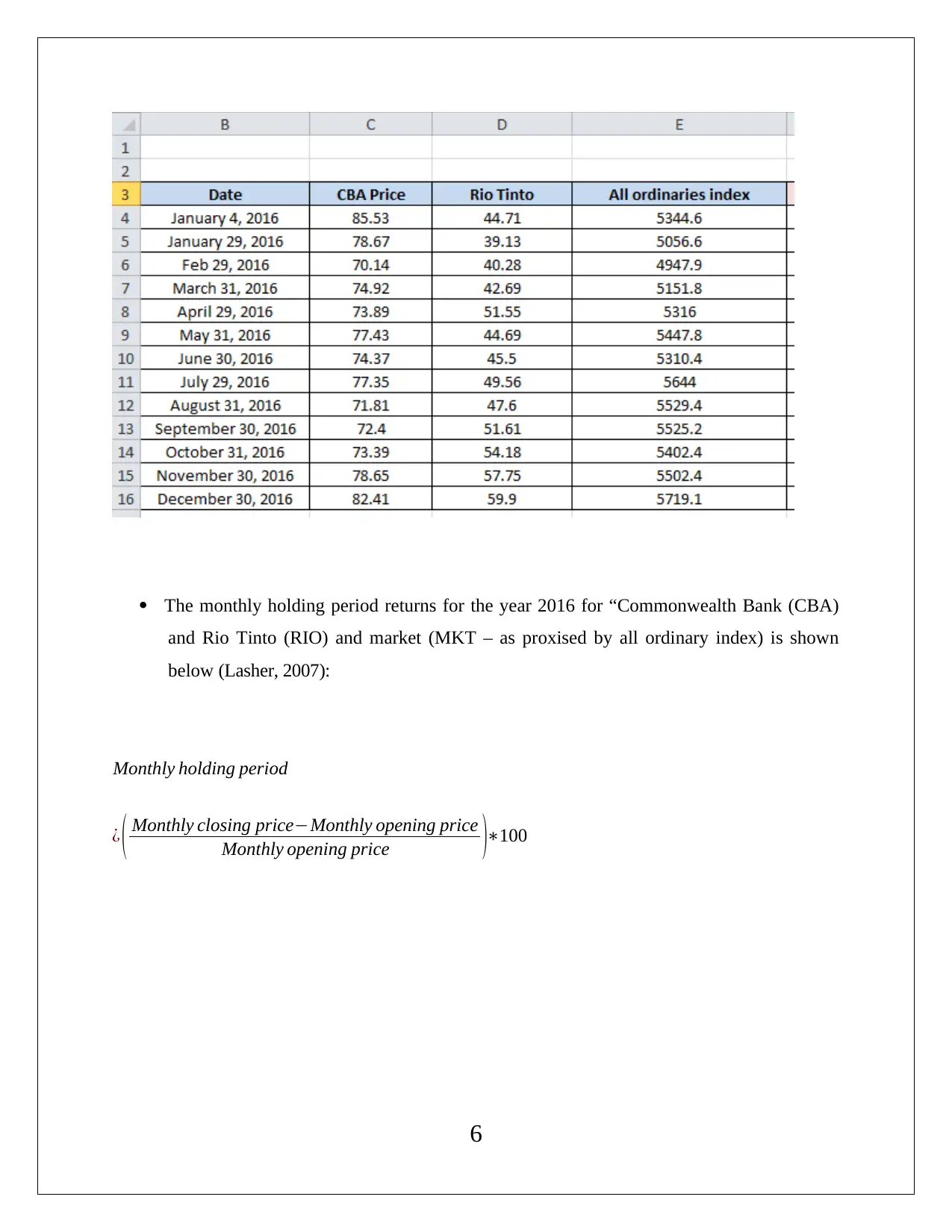
The monthly holding period returns for the year 2016 for “Commonwealth Bank (CBA)
and Rio Tinto (RIO) and market (MKT – as proxised by all ordinary index) is shown
below (Lasher, 2007):
Monthly holding period
¿ ( Monthly closing price−Monthly opening price
Monthly opening price )∗100
6
and Rio Tinto (RIO) and market (MKT – as proxised by all ordinary index) is shown
below (Lasher, 2007):
Monthly holding period
¿ ( Monthly closing price−Monthly opening price
Monthly opening price )∗100
6
Paraphrase This Document
Need a fresh take? Get an instant paraphrase of this document with our AI Paraphraser
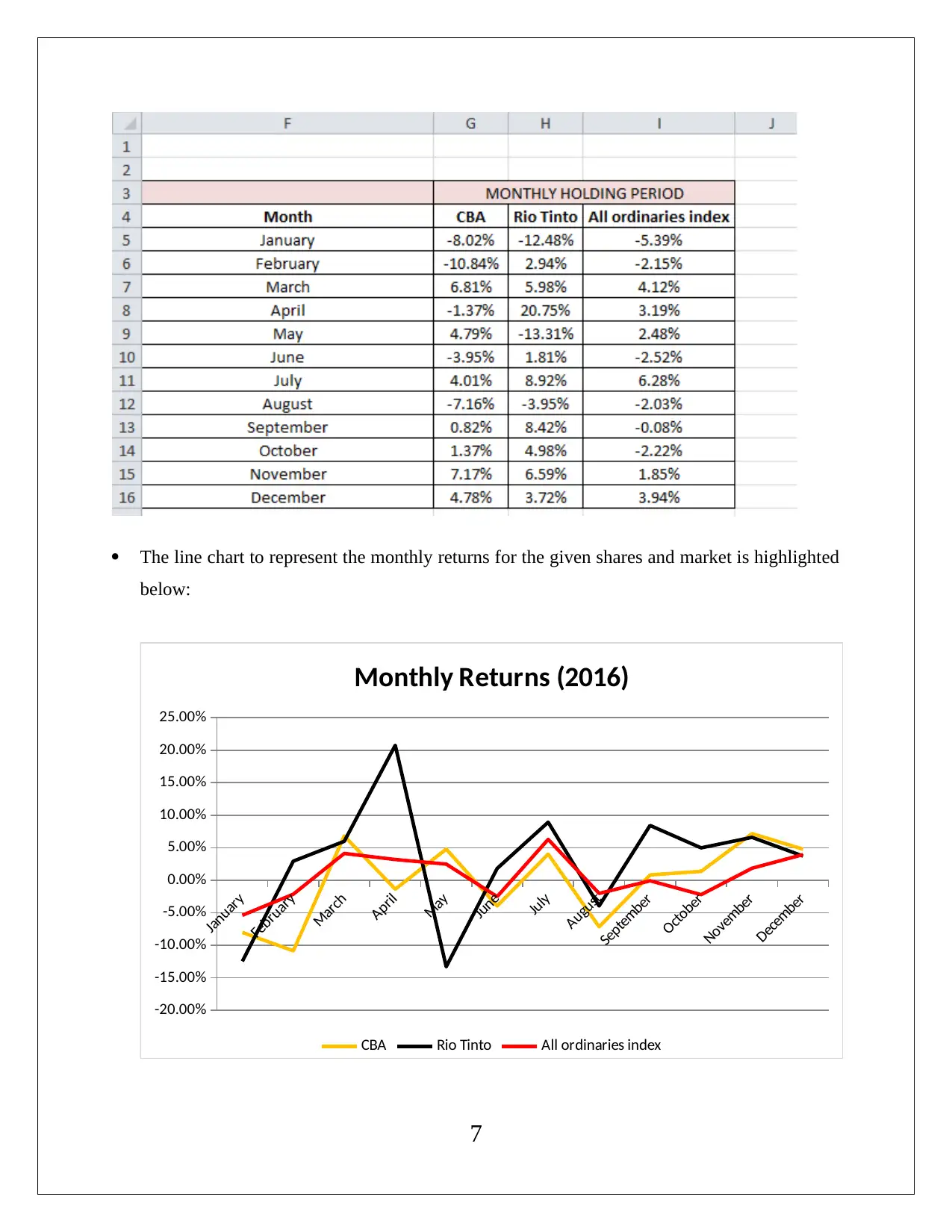
The line chart to represent the monthly returns for the given shares and market is highlighted
below:
January
February
March
April
May
June
July
August
September
October
November
December
-20.00%
-15.00%
-10.00%
-5.00%
0.00%
5.00%
10.00%
15.00%
20.00%
25.00%
Monthly Returns (2016)
CBA Rio Tinto All ordinaries index
7
below:
January
February
March
April
May
June
July
August
September
October
November
December
-20.00%
-15.00%
-10.00%
-5.00%
0.00%
5.00%
10.00%
15.00%
20.00%
25.00%
Monthly Returns (2016)
CBA Rio Tinto All ordinaries index
7
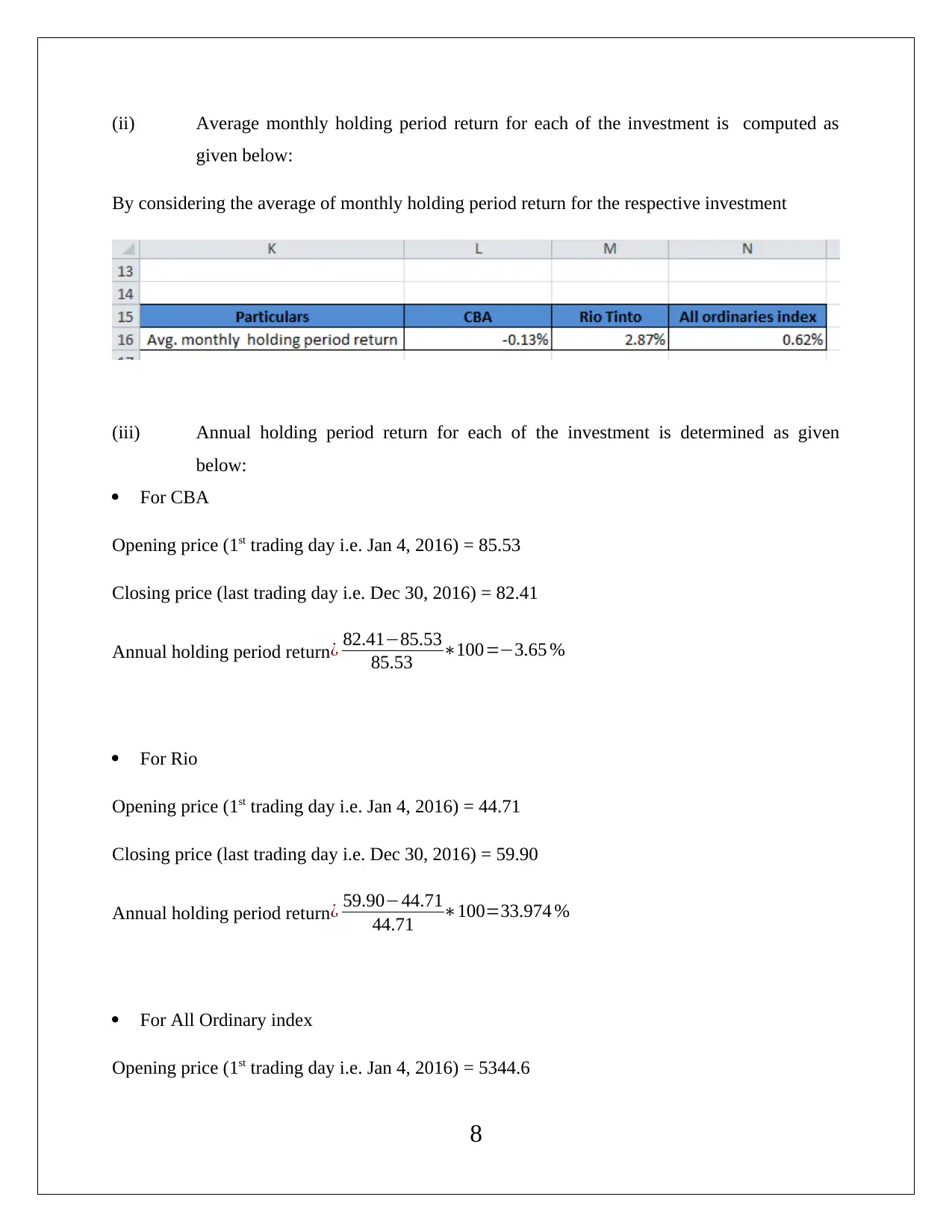
(ii) Average monthly holding period return for each of the investment is computed as
given below:
By considering the average of monthly holding period return for the respective investment
(iii) Annual holding period return for each of the investment is determined as given
below:
For CBA
Opening price (1st trading day i.e. Jan 4, 2016) = 85.53
Closing price (last trading day i.e. Dec 30, 2016) = 82.41
Annual holding period return¿ 82.41−85.53
85.53 ∗100=−3.65 %
For Rio
Opening price (1st trading day i.e. Jan 4, 2016) = 44.71
Closing price (last trading day i.e. Dec 30, 2016) = 59.90
Annual holding period return¿ 59.90−44.71
44.71 ∗100=33.974 %
For All Ordinary index
Opening price (1st trading day i.e. Jan 4, 2016) = 5344.6
8
given below:
By considering the average of monthly holding period return for the respective investment
(iii) Annual holding period return for each of the investment is determined as given
below:
For CBA
Opening price (1st trading day i.e. Jan 4, 2016) = 85.53
Closing price (last trading day i.e. Dec 30, 2016) = 82.41
Annual holding period return¿ 82.41−85.53
85.53 ∗100=−3.65 %
For Rio
Opening price (1st trading day i.e. Jan 4, 2016) = 44.71
Closing price (last trading day i.e. Dec 30, 2016) = 59.90
Annual holding period return¿ 59.90−44.71
44.71 ∗100=33.974 %
For All Ordinary index
Opening price (1st trading day i.e. Jan 4, 2016) = 5344.6
8
⊘ This is a preview!⊘
Do you want full access?
Subscribe today to unlock all pages.

Trusted by 1+ million students worldwide
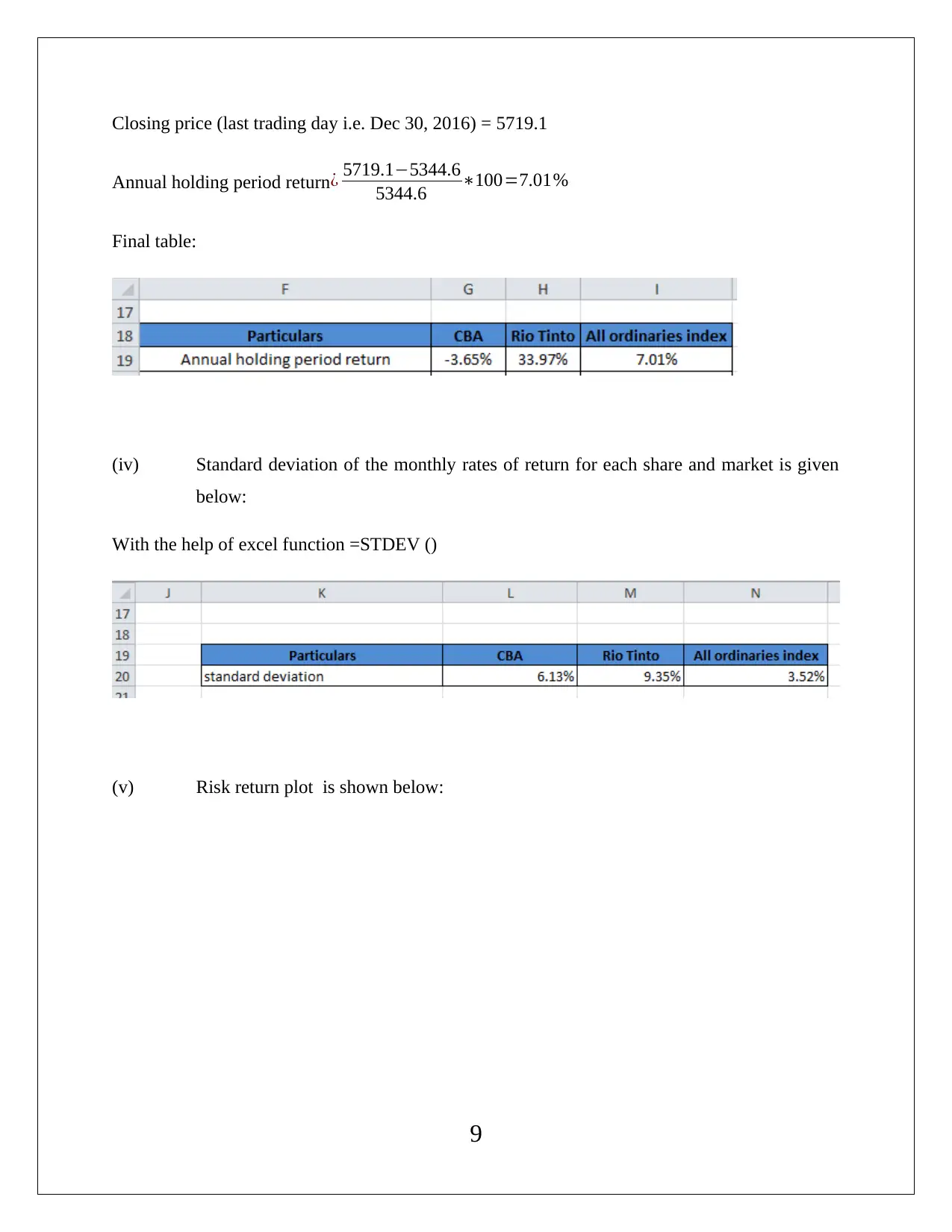
Closing price (last trading day i.e. Dec 30, 2016) = 5719.1
Annual holding period return¿ 5719.1−5344.6
5344.6 ∗100=7.01%
Final table:
(iv) Standard deviation of the monthly rates of return for each share and market is given
below:
With the help of excel function =STDEV ()
(v) Risk return plot is shown below:
9
Annual holding period return¿ 5719.1−5344.6
5344.6 ∗100=7.01%
Final table:
(iv) Standard deviation of the monthly rates of return for each share and market is given
below:
With the help of excel function =STDEV ()
(v) Risk return plot is shown below:
9
Paraphrase This Document
Need a fresh take? Get an instant paraphrase of this document with our AI Paraphraser
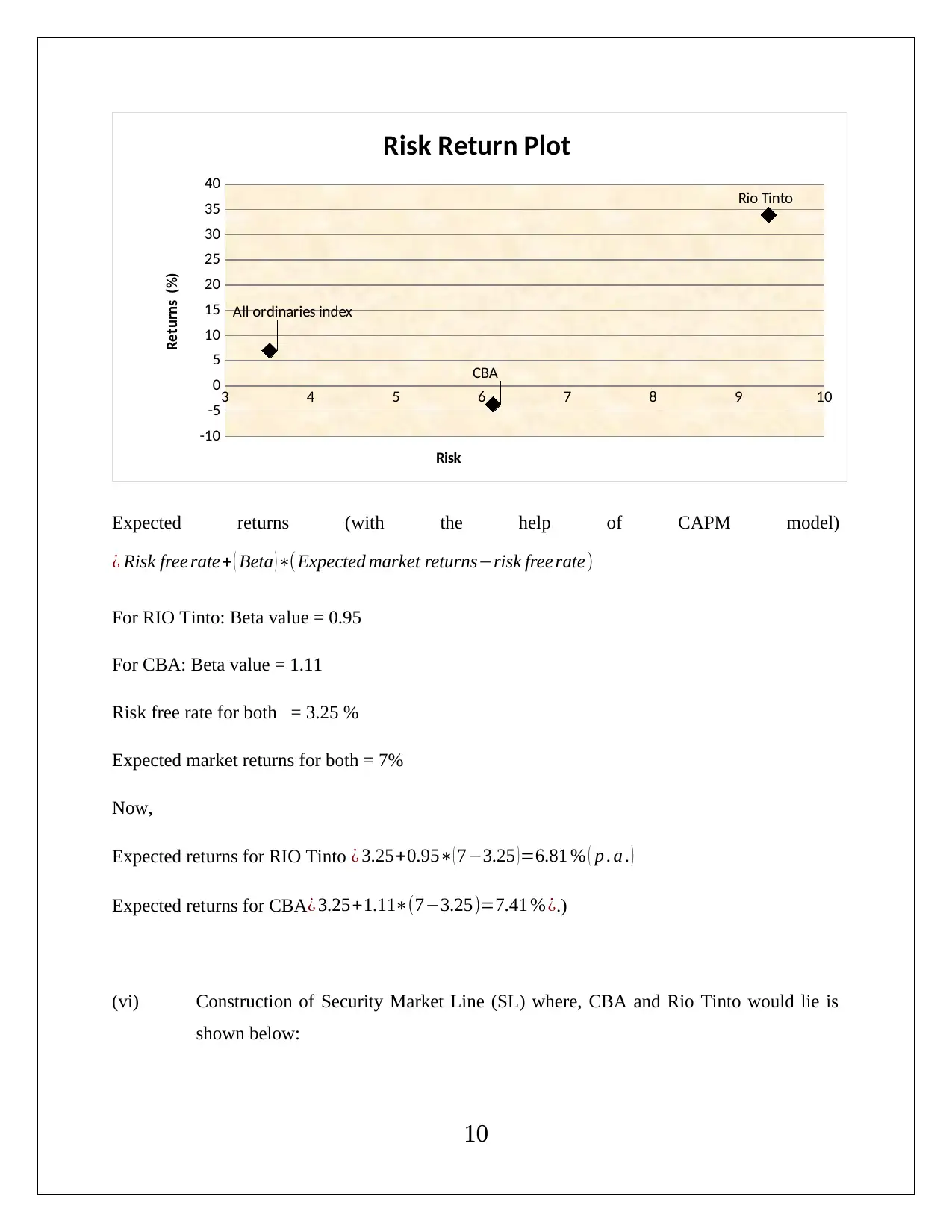
3 4 5 6 7 8 9 10
-10
-5
0
5
10
15
20
25
30
35
40
CBA
Rio Tinto
All ordinaries index
Risk Return Plot
Risk
Returns (%)
Expected returns (with the help of CAPM model)
¿ Risk free rate+ ( Beta )∗( Expected market returns−risk free rate)
For RIO Tinto: Beta value = 0.95
For CBA: Beta value = 1.11
Risk free rate for both = 3.25 %
Expected market returns for both = 7%
Now,
Expected returns for RIO Tinto ¿ 3.25+0.95∗( 7−3.25 ) =6.81 % ( p . a . )
Expected returns for CBA ¿ 3.25+1.11∗(7−3.25)=7.41 %¿.)
(vi) Construction of Security Market Line (SL) where, CBA and Rio Tinto would lie is
shown below:
10
-10
-5
0
5
10
15
20
25
30
35
40
CBA
Rio Tinto
All ordinaries index
Risk Return Plot
Risk
Returns (%)
Expected returns (with the help of CAPM model)
¿ Risk free rate+ ( Beta )∗( Expected market returns−risk free rate)
For RIO Tinto: Beta value = 0.95
For CBA: Beta value = 1.11
Risk free rate for both = 3.25 %
Expected market returns for both = 7%
Now,
Expected returns for RIO Tinto ¿ 3.25+0.95∗( 7−3.25 ) =6.81 % ( p . a . )
Expected returns for CBA ¿ 3.25+1.11∗(7−3.25)=7.41 %¿.)
(vi) Construction of Security Market Line (SL) where, CBA and Rio Tinto would lie is
shown below:
10
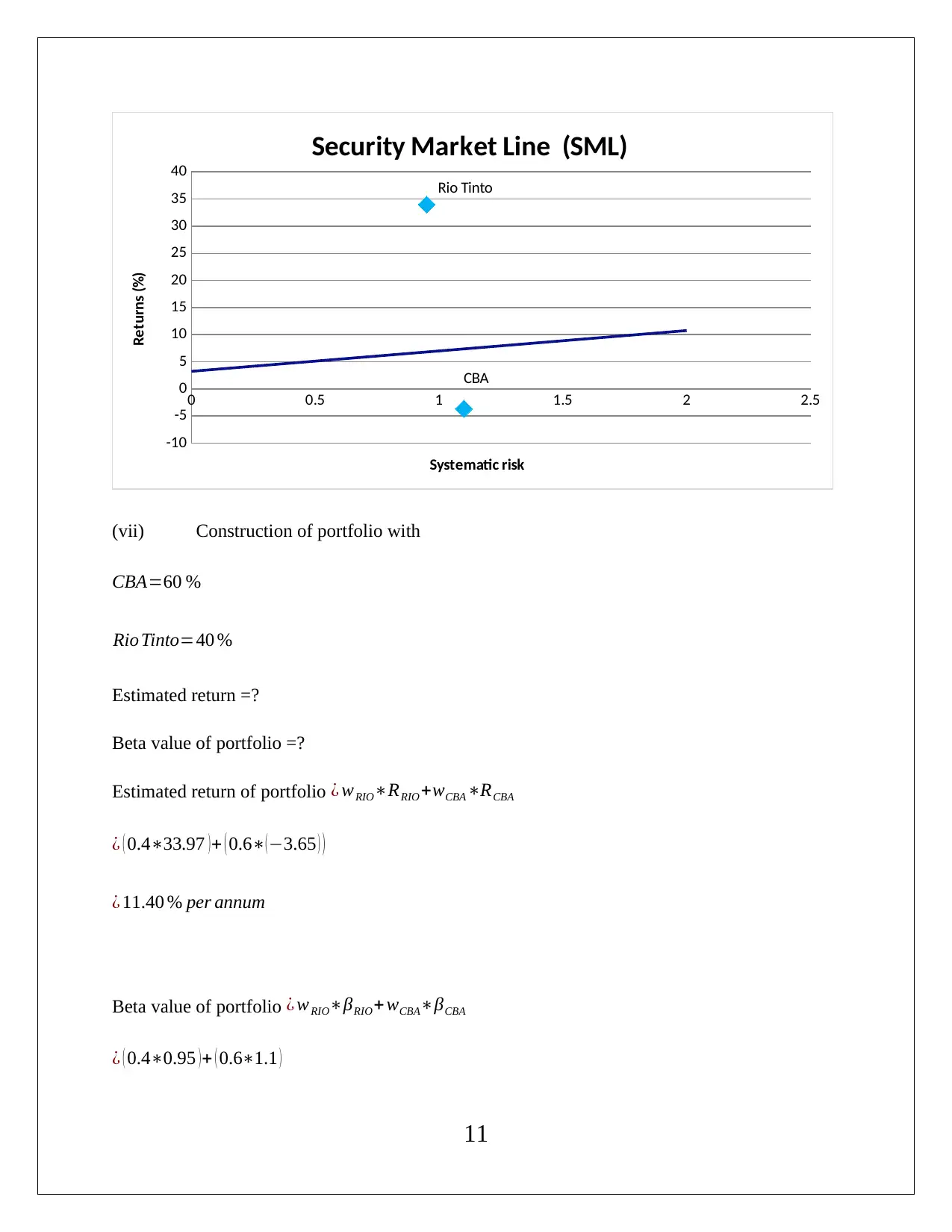
0 0.5 1 1.5 2 2.5
-10
-5
0
5
10
15
20
25
30
35
40
CBA
Rio Tinto
Security Market Line (SML)
Systematic risk
Returns (%)
(vii) Construction of portfolio with
CBA=60 %
Rio Tinto=40 %
Estimated return =?
Beta value of portfolio =?
Estimated return of portfolio ¿ wRIO∗RRIO +wCBA ∗RCBA
¿ ( 0.4∗33.97 ) + ( 0.6∗( −3.65 ) )
¿ 11.40 % per annum
Beta value of portfolio ¿ wRIO∗βRIO+ wCBA∗βCBA
¿ ( 0.4∗0.95 )+ ( 0.6∗1.1 )
11
-10
-5
0
5
10
15
20
25
30
35
40
CBA
Rio Tinto
Security Market Line (SML)
Systematic risk
Returns (%)
(vii) Construction of portfolio with
CBA=60 %
Rio Tinto=40 %
Estimated return =?
Beta value of portfolio =?
Estimated return of portfolio ¿ wRIO∗RRIO +wCBA ∗RCBA
¿ ( 0.4∗33.97 ) + ( 0.6∗( −3.65 ) )
¿ 11.40 % per annum
Beta value of portfolio ¿ wRIO∗βRIO+ wCBA∗βCBA
¿ ( 0.4∗0.95 )+ ( 0.6∗1.1 )
11
⊘ This is a preview!⊘
Do you want full access?
Subscribe today to unlock all pages.

Trusted by 1+ million students worldwide
1 out of 15
Related Documents
Your All-in-One AI-Powered Toolkit for Academic Success.
+13062052269
info@desklib.com
Available 24*7 on WhatsApp / Email
![[object Object]](/_next/static/media/star-bottom.7253800d.svg)
Unlock your academic potential
Copyright © 2020–2025 A2Z Services. All Rights Reserved. Developed and managed by ZUCOL.





